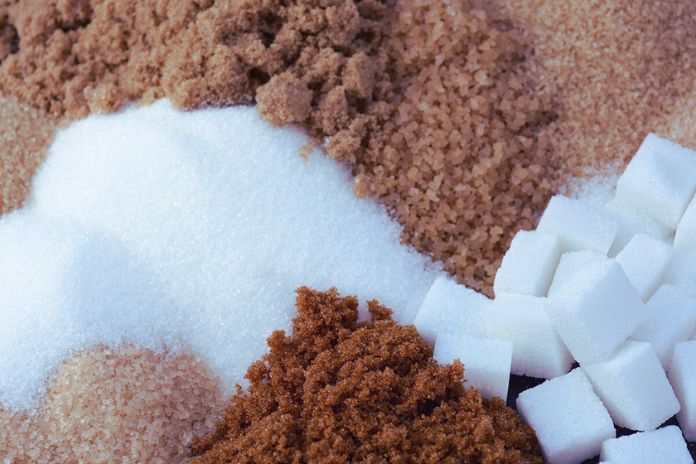Who arrives at the supermarket shelf today may even need clarification on so many types of sugar.
Refined and crystal sugar has been on the market for a long time. The rarer brown became common on the shelves.
However, in addition to these, there are currently many others: organic, demerara, light, coconut… Not to mention the sweeteners that propose to replace sugar.
Many options can be confusing for those looking to make healthier choices. After all, is there a big difference between them? What is the safest type of sugar to consume?
You will discover the answers in this article. So, read on!
What Are The Types Of Sugar?
Learn about the main types of sugar, their origin, and their differences from others:
Refined Sugar
Refined sugar is the most used in Brazil. It is derived from sugar cane, which undergoes a process of juice extraction, crystal production, and refinement.
However, anyone who knows sugarcane juice or brown sugar knows they are not as white as the sugar at the table.
Therefore, to reach this result, the industry must remove all the molasses, which uses a series of chemical additives, such as sulfur.
In this process, in addition to receiving substances that are harmful to health, sugar loses vitamins and mineral salts present in sugarcane in its natural state.
Sucrose accounts for more than 99% of the composition of refined white sugar. When consuming it, the person feels only the sweetness and does not perceive any residue of sugarcane flavor.
This carbohydrate generates a very strong stimulus in certain brain regions, making many people feel addicted to sugar.
In addition to contributing to the increase in obesity, consuming this sugar is also related to heart problems, the development of diabetes, cavities, and a series of metabolic disorders.
Brown Sugar
Brown sugar is also a product made from sugar cane.
However, in this case, the manufacturer keeps the molasses in the product and does not carry out the complete refining process.
For this reason, brown sugar is brown and has a cane flavor, which is not the case with refined sugar.
As brown sugar does not go through the entire refining process, it still preserves some mineral salts such as calcium, iron, manganese, potassium, zinc, and vitamins A, B1, B12, and B5, among others.
However, brown sugar still has a high concentration of sucrose in its composition, which varies between 85 to 93%.
Crystal Sugar
Also derived from cane, crystal sugar has yet to go through the complete refinement process.
Even for that reason, it comes in larger crystals, more difficult to dissolve in water, juices, and other drinks.
However, the manufacturer also removes all the molasses and 90% of the vitamins that the cane provides.
Crystal sugar is among those with the highest concentration of sucrose. The percentage is at least 98.5%, which is extremely harmful to health.
Raw Sugar
Demerara sugar is a product that has been commercialized on a large scale in recent years. Until recently, the consumer could only find it in specialized stores.
By going through a lighter refining process without chemical additives, demerara sugar preserves some of sugarcane’s nutrients.
However, as with other sugars, it contains a high percentage of sucrose in its composition (96%).
Organic Sugar
The manufacture of organic sugar does not use pesticides, fertilizers, or artificial ingredients.
Therefore, from the cane plantation to the product’s packaging, there is some care in preserving it from chemical additives.
However, this remains the fact that it is as caloric as other types of sugar and with the same concentration of sucrose in its composition.
It does not use additives, so its refining process is interrupted before traditional sugar. Thus, it has a darker color and thicker crystals.
Light Sugar
Light sugar arrived at supermarkets with a proposal that was the solution for many people: the sharp sweetness of common sugar but with a much smaller amount of calories.
However, it is important to look at the label and analyze the information described there very well.
In the best-selling brand in the country, this does not correspond to reality. The label of the light version indicates 10 calories (kcal) for each portion of 2.5 grams.
The traditional version of the same brand, on its label, informs it has 20 calories — twice as much as the light version — but also informs a double portion of 5 grams.
This means that the calories are the same unless the information released by the brand itself is wrong.
But still, what makes sugar light? By law, to use this title, foods must contain at least a 30% reduction in one of its components.
High Fructose Syrup
Fructose is the natural sugar in fruits and cereals, such as corn.
You are consuming fructose when you eat mango, pineapple, watermelon, and other fruits.
The problem starts when the industry extracts substances from natural foods to use in isolation. With fructose, it is no different.
Several products on the market use fructose to sweeten. These are high fructose or glucose syrups, sometimes called corn syrup.
They look and feel like honey, but they have different nutritional values.
It is a highly caloric and artificial compound, which makes food sweet but does not add vitamins or mineral salts.
The food industry widely uses high fructose or glucose syrup to manufacture cookies, candies, soft drinks, and other products.
Coconut Sugar
Although it has been pointed out recently as the best alternative for sweetening preparations, it is important to be aware of some facts.
It is richer in nutrients than sugars made from cane. Another advantage is its lower glycemic index than other sweetening options.
This is because it has a fiber called inulin, which slows down glucose absorption into the blood and prevents the formation of insulin spikes.
Also Read: Light Drinks: Sugar-Free Soft Drinks Are That Healthy

